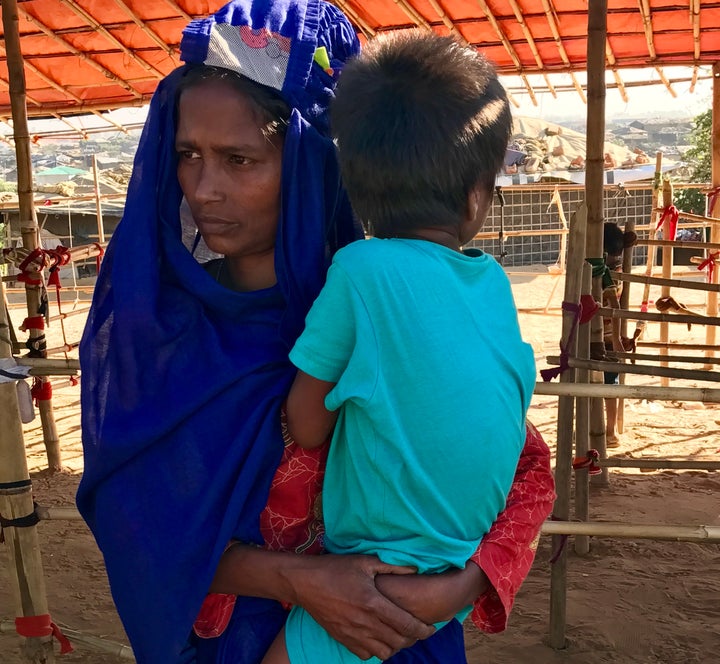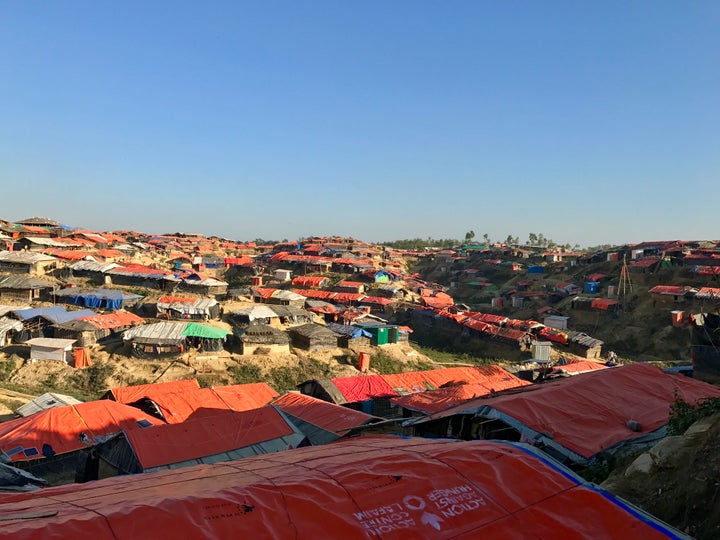
Imagine a place where over half the population is under 18, and most of the adult population are women, many of whom have been raped at gunpoint. A place where everyone shares the recent trauma of fleeing their home with only the clothes on their back, witnessing family members being tortured, burned and killed. Welcome to Kutupalong, Bangladesh.
Kutupalong, one of the largest refugee camps in the world, is home to over a million Rohingya refugees from Myanmar, over 600,000 of whom arrived in the last four months.
In early December, I spent three days in Kutupalong. I had been invited by one of the founders of the To: platform, with whom I had recently visited the Nakivale refugee camp in Uganda, searching for new ways of addressing the challenge of the global refugee crisis. We were in Bangladesh with others from the Love Army, and my job was to listen to Rohingya refugees. Here are some of their stories.
Ten-year-old Said arrived two or three days before we met. He couldn’t remember exactly when, or how long the journey took. All he knows is he and his siblings fled after watching Burmese soldiers kill their parents, scared that the soldiers would find and kill them too.
Such horror stories are the norm in Kutupalong.
Hadara, like many Rohingya refugees, doesn’t know the fate of a loved one. After seeing soldiers kill her husband in August, Hadara fled her home near Buthidaung in the Rakhine state of Myanmar with her five children. Their seven-day journey involved trekking through forests at night she said because “if the soldiers or the extremist Buddhists saw us, they would kill us. We were hiding, running to protect our lives.” Only four of her children made it to Kutupalong, Hadara lost her 10-year-old daughter along the way, “She might be dead. I don’t know. Everyone was running to protect their life. I couldn’t find her. I have no news if she is alive or not.”
Two months ago, shooting erupted in Khadija’s village, and the family fled when her cousin was killed, as “soldiers were shooting people, capturing women and cutting their eyes out” before burning down their homes. Khadija became separated from her husband as soldiers shot at them from helicopters, but “we continued to walk without looking back.” She doesn’t know if he is dead or alive.
Khadija was not the only refugee who reported women being blinded by the military. Mahboba, 24, told us that soldiers captured his wife as they fled and “cut her eyes with a knife.” When Roshida’s village was raided two months ago, “the military killed everyone and burned down the houses.” She said soldiers killed her brother-in-law and captured her sister: “They shot her in the eyes. She fled with her eyes shot out.”
I learned that the soldiers had a system. Before villages were burned to the ground, almost everyone spoke of helicopters hovering overhead with soldiers shooting “from the skies.” Jamilah, 23, told me that when the helicopters landed in her village, soldiers “took the women from their houses and raped them before forcing people inside at gunpoint and burning the houses down with people inside.” Jamilah estimated the population of her village to have been “250 families” and that some 200 women and girls were raped, including her sister. When they fled, they “hid in the mountain during the day, and walked at night” while being hunted by soldiers.
The men, it seems were targeted for death, the women for torture. Another member of the Love Army spoke to a woman who had been raped by ten soldiers, her husband was forced to watch at gunpoint. The soldiers then doused him and their two children in gasoline, marched him and the children into their home at gunpoint and burned it down in front of her. Her husband and children remained inside.

Pregnant women were less likely to be tortured, but for them the days-long treks without food were especially perilous. Thirty-four-year-old Ramsha invited me into her tent, where she lit a small fire for warmth. The tent was uncomfortably hot on the humid 85-degree day, but Ramsha shivered with a high fever, her right hand resting on her infant son, who lay on the ground next to her. She made the 15-day trek with her husband and nine children, while she was late in her third trimester. They had occasionally paused at villages along the way so Ramsha might rest, but every village they stopped at was attacked and burned down by soldiers. Ramsha nonetheless felt fortunate; she had her children and her husband, and she had not been assaulted.
While Kutupalong is overcrowded, disease is spreading, and sanitation is a challenge. But at least the traumatized refugees can sleep without the sound of gunfire or the smell of homes burning. But their lives have been disrupted beyond recognition, thrown into an unimaginable uncertainty. In Myanmar, Hadara’s husband owned rice paddies, but in Kutupalong “our life depends on donations.” So do many others.
A vast number of Bangladeshis, and some Rohingya, have set up small shops in Kutupalong, selling food and other necessities. Because refugees are not allowed to leave, shops can charge extortionate prices. Consequently, drug gangs and pimps allegedly operate in the camp, exploiting refugees’ need for income.

How extensive is criminal activity in Kutupalong? I asked a group of Bangladeshi soldiers on police duty who denied that crime exists in the area. But we had already observed some soldiers on duty beat refugees with sticks at a food distribution center, so I was already rather skeptical of the military. My translator stuck to the official line when I mentioned later that it was inconceivable that there wasn’t any crime given the size of the population. Aid workers were more forthcoming. One told us of reports that children had been abducted and sold to outsiders, and a health worker told us that female refugees had been raped in the camp by “local men, Bangladeshi men.” When I mentioned this to Rohingya women, asking if it was true, they refused to answer.
Add criminal activity and refugee abuse to the already mind-boggling challenges faced by those tasked with managing camp infrastructure and the needs of a rapidly growing and deeply traumatized population, and it would seem that the Kutupalong crisis has only just begun. Imran, one of my translators, had been a 21-year-old tech entrepreneur in Myanmar, until his father was killed, forcing Imran to flee to Bangladesh with his mother. “We had a good life,” he told me, “but our luck is dead.”
